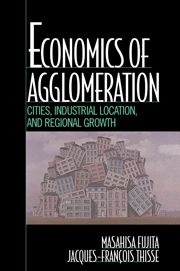Book contents
- Frontmatter
- Contents
- Acknowledgments
- 1 Agglomeration and Economic Theory
- PART I FUNDAMENTALS OF GEOGRAPHICAL ECONOMICS
- PART II THE STRUCTURE OF METROPOLITAN AREAS
- PART III FACTOR MOBILITY AND INDUSTRIAL LOCATION
- 8 Industrial Agglomeration under Marshallian Externalities
- 9 Industrial Agglomeration under Monopolistic Competition
- PART IV URBAN SYSTEMS AND REGIONAL GROWTH
- References
- Name Index
- Subject Index
9 - Industrial Agglomeration under Monopolistic Competition
Published online by Cambridge University Press: 05 June 2012
- Frontmatter
- Contents
- Acknowledgments
- 1 Agglomeration and Economic Theory
- PART I FUNDAMENTALS OF GEOGRAPHICAL ECONOMICS
- PART II THE STRUCTURE OF METROPOLITAN AREAS
- PART III FACTOR MOBILITY AND INDUSTRIAL LOCATION
- 8 Industrial Agglomeration under Marshallian Externalities
- 9 Industrial Agglomeration under Monopolistic Competition
- PART IV URBAN SYSTEMS AND REGIONAL GROWTH
- References
- Name Index
- Subject Index
Summary
INTRODUCTION
The spatial economy is replete with pecuniary externalities. For example, when some workers (firms) choose to migrate, they are likely to affect both the labor and product markets in their region of origin as well those in their region of destination. Such pecuniary externalities are especially relevant in the context of imperfectly competitive markets because prices do not perfectly reflect the social values of individual decisions. Pecuniary externalities are also better studied within a general equilibrium framework to account for the interactions between the product and labor markets. Among other things, this allows one to study the dual role of individuals as workers and consumers. At first sight, this seems to be a formidable task. Yet, as shown by Krugman (1991a), several of these various effects can be combined and studied within a relatively simple general equilibrium model of monopolistic competition, which has come to be known as the core–periphery model.
Recall that monopolistic competition à la Chamberlin (1933) involves consumers with a preference for variety (varietas delectat), whereas firms producing these varieties compete for a limited amount of resources because they face increasing returns. The prototype that has emerged from the industrial organization literature is the model developed by Spence (1976) and Dixit and Stiglitz (1977), which is sometimes called the S-D-S model. These authors assumed that each firm is negligible in the sense that it may ignore its impact on, and hence reactions from, other firms, but retains enough market power for pricing above marginal cost regardless of the total number of firms (like a monopolist).
- Type
- Chapter
- Information
- Economics of AgglomerationCities, Industrial Location, and Regional Growth, pp. 303 - 348Publisher: Cambridge University PressPrint publication year: 2002



